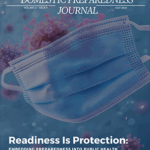According to the U.S. Department of Homeland Security, the U.S. Food and Agriculture Sector (Food/AG) accounts for 20% of the national domestic product. The food and agriculture industry serves as the backbone of the U.S. economy, supporting communities and families around the nation and globally. During the pandemic, local farmers lost an estimated $688.7 million in sales and a total loss to the economy of approximately $1.32 billion. For example, one of the most impacted farming sub-sectors to be affected by COVID-19 was the dairy industry. Over 3,000 dairy farms had to dump milk and close operations due to low demand. In the 21century, this sector has become increasingly more complex, and the COVID-19 global pandemic exposed weaknesses, which included food supply chain interruptions, excess milk production, less demand for bio-fuels with less driving, less demand for food as restaurants closed, and other impacts. Dangers in this sector exist on local, national, and international scales. These threats highlight this sector as a vulnerable area and a potential target for foreign threat actors and natural hazards.
FEMA has designated lifeline sectors. While the Food/AG sector is combined with hydration and shelter, the focus is not necessarily resilience but response to provide food, hydration, and shelter to victims. The U.S. Department of Homeland Security defines Food/AG as a critical infrastructure but not a prioritized infrastructure. With the sector’s thin profit margins, incidents and threats continue to plague the sectors and sub-sectors’ dependencies and inter-dependencies. Contextualizing threats and efforts in Food/AG helps highlight the importance of industries in this sector and the complex nature of threats and risks that its stakeholders face. In addition, new and emerging mitigation measures can make the sector more resilient.
Food and Agriculture Sector Overview
National Geographic states that, since the Neolithic period, agriculture has been one of the driving forces behind thriving cultures for more than 10,000 years. Today, the U.S. food and agriculture industry still thrives off basic needs and primary functions like water, rotation of seasonal planting and harvesting, and animal husbandry. However, technological advances, population increases, and withering farmland pose risks to this sector. The U.S. is a leader in food production, but increases in population and decreases in farmland have an impact, “According to USDA’s estimates 6.6 million acres of US Farmland has been lost from 2008 through 2015, with a 1 million acre decline last year alone.”
Food and agriculture production heavily rely on average temperatures and weather conditions, biological and natural systems, and intergenerational knowledge and experience. As populations grow and farmland shrinks, more processed foods are being produced to meet demands. Corn and other crops are being genetically modified to help build resilience against damage.
Legacy systems and weather-pattern familiarity are vital to maintaining a thriving and profitable food and agriculture sector and sub-sectors. In 2023, the average profit margin for farmers was about 2%. Operational overhead costs like fuel, labor, and insurance impact the farmer’s bottom line. Additional threats like ransomware, data breaches, malware attacks, bioterrorism, financial instability, and rising costs all impact these margins. The decreased profitability driving farm families to sell land and cease operations has a significant impact on the domestic and global food supply.
Is Technology Good for the Agriculture Industry?
To stay profitable and sustainable, farmers must find creative ways to integrate technology into their farming practices and business continuity plans. The new but still learning Norm AI (artificial intelligence that assists with regulatory compliance queries) is specific to the food agriculture industry, but other technological advancements for this sector continue. Technological integration within the industry helps with effective decision-making and keeps farmers safe by promoting environmental sustainability and conservation. The intersection of technology with traditional tactics and processes, which heavily depend on seasons and natural cycles, adds to complex challenges and threats. Farmers continue to face physical risks, such as suffocation from engulfment or entrapment, explosions due to high amounts of grain dust, falls from extreme heights, or crushing and amputation from grain equipment. The 2019 data from the U.S. Bureau of Labor Statistics indicates that the agricultural sector is still the most dangerous in America with 573 fatalities, or an equivalent of 23.1 deaths per 100,000 workers. The combination of physical risks, complex commodities markets, changing environments, resource demands, and supply chain stressors can cause interruptions in food supply-chain systems. This complex problem creates significant challenges within the Food/Ag sector.
Balancing technology, old-world agrarian cultivation techniques, and an informed, forward-thinking mindset is the answer to sustainability in farming. During the COVID-19 pandemic, weakness in the Food/Ag sector was exposed. Issues like market volatility, supply-chain disruptions, and personnel and resource deficiencies demonstrate the fragility of the existing framework. Despite low profit margins and major setbacks caused by natural hazards and disasters, this sector continues to find innovative solutions. Learning to embrace technological changes with an experiential mindset while preserving old-school techniques will reap future gains. Methods and processes that use emerging technologies include precision agriculture, vertical farming, cultured meats, livestock tracking, drones for distributing seeds and pesticides, and many others. Balancing and integrating new concepts and technological advancements with an old-school farming mentality will keep this sector resilient and thriving when battling cyber and environmental threats.
Identifying How to Improve
Change management can be challenging to implement. Old-world mentality, especially in the farming industry, is hard to change due to traditional and proven farming methods. Remaining up to date on market volatility and cyberthreats within the Food/AG sector is pivotal to staying resilient by understanding inevitable changes and the necessary actions to stay in business and be prepared for emergencies. However, combining business continuity methods and traditional farming practices can have significant effects. For example, cropland traditionally remains bare between harvesting seasons, but planting cover crops between seasons can help soil function by suppressing weeds and reducing herbicide use. Another example is training operators to integrate precision farming GPS systems with standard visual observation practices in case positioning, navigation, and timing signals are lost or diminished. This improves the ability to plant and harvest on time. Cross-sector collaboration, human interface, and partner collaboration are the foundation for improvements and progress. The Food and Agriculture-Information Sharing and Analysis Center (Food and Ag-ISAC) is one organization that facilitates information sharing and threat and risk awareness across the industry.
STOP STOPPING A growing body of research shows that often what looks like “multitasking” is actually “rapid task-switching,” especially when technology is involved. —2015 Old Farmer’s Almanac
Industry farmers and partners have detailed views of their environments, margins, and challenges. In general, modern farm families embrace technology and integrate new mindsets that adapt to new legal and regulatory frameworks as they prepare for planting and harvesting seasons. Recent legislative actions include the 2021 presidential Executive Order on Promoting Competition in the American Economy, which reaffirms and clarifies the Packers and Stockyards Act regulation and makes available $200 million to expand competition in meat processing and $25 million in workforce training. Investing in training, emerging agriculture products, and technological advancements will help U.S.-based farms compete. Another legislative action in support of the industry was the Agriculture Improvement Act of 2018 (2018 Farm Bill), which provided a five-year continuation and reform of agricultural and other programs. For example, the Farm Support Program maintains and, in some cases, expands support for farmers through crop insurance programs, commodity support programs, and conservation initiatives to provide a safety net for farmers facing market volatility and natural disasters.
Data is currency in today’s adaptation of technology. As the Food and Agriculture industry remains beholden to seasons and yields, the data gleaned from these practices is gold for farmers. The Farmers’ Almanac, which is used by farmers and others to predict long-range weather forecasts, for example, uses data and patterns to make long-term predictions. Through regenerative agriculture and farming practice sustainability, it is possible to sustain soil, re-use it efficiently, and still produce food on a global scale.
Without protecting and regenerating the soil on our 4 billion acres of cultivated farmland, 8 billion acres of pastureland, and 10 billion acres of forest land, it will be impossible to feed the world. —Regenerative Agriculture
With trends in farmland loss, technological advancements will become a top priority for U.S. and global Food/Ag decision-makers. With farming culture and practices adapting to significant variations in average weather conditions and other threats, available tools and best practices can help mitigate threats and improve efficiency and yields.
Solutions Abound
The loss of healthy food and the ability to sustain agriculture would cause cascading impacts across other sectors, on the general health of the public, and on other human support services. Supply chains, financial markets, military readiness, and more are dependent on nutritious, sustainable, and attainable food sources. Solutions to the security and resilience of the food and agriculture industry can be challenging to identify and difficult to implement, but they are the responsibility of whole communities, not just farm families or the government. Following are examples of how industry partners can help with Food/AG resilience:
- Connect local and state partners with owners and operators of small and large farms and include them in tabletop exercises and other preparedness and business continuity efforts.
- Learn the roles and responsibilities of industry and government in cooperation and recovery efforts specific in the Food/AG industry.
- Understand cross-sector dependencies and impacts and build resilience into business continuity processes (e.g., transportation or energy backup processes in case of mechanical breakdown or natural disasters) that depend on realistic measures of livestock survivability, crop sustainment, refrigeration, etc.
- Integrate and better understand efficiencies in precision farming practices for small and large operations (e.g., effective drone use for spraying chemicals only when needed or more efficient ways to pick up rocks that damage combines).
Implementing new technologies in the Food/Ag industry is paramount when implementing mitigation efforts for sustainable and resilient farming. Farm families and all levels of government must prioritize conversations on threats and farming risks. Perishable commodity production that sustains life and the industry is a necessary endeavor. The ability to balance old-school best practices and data-driven solutions impacts short-term and long-term goals, so staying up to date on legislative efforts, regulations, and emergency response will be crucial to sector sustainment after emergencies. Farmers have experienced the consequences of long-term shifts in average temperature and weather conditions, mechanical failures, and market volatility. With family farms transitioning to the next generation and cyber and physical threats emerging locally and abroad, all key stakeholders must stay invested in the food and agriculture industry and focus efforts on resiliency, not just response and recovery.

Nathan DiPillo
Nathan DiPillo currently serves as a California Governor’s Office appointee assigned to the California Office of Emergency Services as a Critical Infrastructure Analyst in the State Threat Assessment Center. Before state service, he functioned as a critical infrastructure specialist with the Department of Homeland Security, Cybersecurity and Infrastructure Security Agency (CISA). He also spent over 15 years with the Transportation Security Administration, where he assisted in standing up the agency with policy development, training, and recruitment. He has over 25 years in the emergency management and security industry, beginning as a resident firefighter/emergency medical technician. He also served with the California State Military Department, and Army National Guard in the 223rd Training Command ending his career as a Sergeant First Class. During that time, he served in many units, finishing his career attached to the 102nd Military Police Training Division in an Opposition Force Unit. He currently serves on a small-town planning commission and assisted in coordinating an emergency family communications group in his local area. He possesses a Master of Emergency Management/Homeland Security from the National University and other Federal Emergency Management Agency (FEMA), U.S. Department of Homeland Security (DHS), and military certifications.
- Nathan DiPillohttps://domesticpreparedness.com/author/nathan-dipillo
- Nathan DiPillohttps://domesticpreparedness.com/author/nathan-dipillo
- Nathan DiPillohttps://domesticpreparedness.com/author/nathan-dipillo
- Nathan DiPillohttps://domesticpreparedness.com/author/nathan-dipillo





